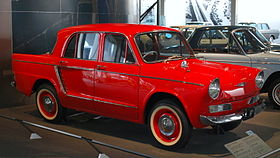Hino Contessa
| Contessa PC series | |
|---|---|
 |
|
| Overview | |
| Manufacturer | Hino Motors |
| Production | 1961–1964 |
| Assembly |
Hamura, Tokyo, Japan Haifa, Israel |
| Body and chassis | |
| Class | compact |
| Body style | 2-door coupé 4-door sedan |
| Layout | RR layout |
| Related |
Hino Briska Renault 4CV |
| Powertrain | |
| Engine | 893 cc GP20 inline-4 |
| Transmission | 3/4-speed manual |
| Dimensions | |
| Wheelbase | 2,150 mm (84.6 in) |
| Length | 3,795 mm (149.4 in) 3,830 mm (150.8 in) (Sprint) |
| Width | 1,475 mm (58.1 in) |
| Height | 1,415 mm (55.7 in) 1,200 mm (47.2 in) (Sprint) |
| Curb weight | 750 kg (1,650 lb) 650 kg (1,430 lb) (Sprint) |
| Chronology | |
| Predecessor | Hino Renault (series PA) |
| Contessa PD series | |
|---|---|

Contessa 1300 Deluxe sedan (PD100)
|
|
| Overview | |
| Manufacturer | Hino Motors |
| Production | 1964–1969 |
| Assembly |
Hamura, Tokyo, Japan Haifa, Israel Thames, New Zealand |
| Designer | Giovanni Michelotti |
| Body and chassis | |
| Class | compact |
| Body style | 2-door coupé 4-door sedan |
| Layout | RR layout |
| Platform | PD 100/200/300/400 |
| Related |
Hino/Toyota Briska Renault Dauphine |
| Powertrain | |
| Engine | 1251 cc GR100 I4 |
| Transmission | 3/4-speed manual |
| Dimensions | |
| Wheelbase | 2,280 mm (89.8 in) |
| Length | 4,150 mm (163.4 in) |
| Width | 1,530 mm (60.2 in) |
| Height | 1,390 mm (54.7 in) |
| Curb weight | 888–940 kg (1,958–2,072 lb) |
The Hino Contessa is an automobile which was produced by Hino Motors from 1961 to 1967.
The Contessa was developed largely from the 1947-1961 Renault 4CV powertrain under license to Hino Motors. Offered in both coupe and sedan bodystyles, it replaced the Hino Renault, which was the Renault 4CV manufactured by Hino for Japan. It was adapted into a small pickup truck called the Hino Briska, but used a front engine and rear drive powertrain, while the Contessa used a rear engine and rear drive setup. The PC series coupé was designed by Giovanni Michelotti, while the second generation was longer and wider in both coupé and sedan bodystyles.
Unlike many cars found internationally of this time period, using rear drive and rear engined powertrains, the Contessa was water-cooled rather than air-cooled. The name contessa is Italian for a countess.
47,299 of the PC-series Contessa were built, between April 1961 and the second quarter of 1964. With an 893 cc version of the Renault-based GP engine, max power is 35 PS (26 kW; 35 hp) which provides a top speed of 110 km/h (68 mph). The first Contessa originally received a three-speed column mounted shifter, later a four-speed manual became optional, utilizing an electromagnetic clutch apparatus called Shinko-Hinomatic. The gear change came in for a certain amount of criticism, a result of its long and cumbersome linkage from the steering column to the rear-mounted transmission.
As Hino had a business relationship with Renault at the time, and the powertrain was largely adapted from an existing Renault product, there are clear similarities to the Renault Dauphine. The drivetrain and suspension were carried over from the Hino Renault (PA). The main improvement over the 4CV was that the Contessa 900 was a full five-seater, making it a much stronger competitor. The engine was installed longitudinally, meaning the radiator was against the outer edge of the engine bay, whereas the Renault installed the radiator against the firewall, and the Hino engine sat in a north-south orientation with the transmission attached inside the engine bay next to the Contessa's firewall. The engine was slanted to the left, and utilized a crossflow cylinder head. The rear suspension used swing axles.
...
Wikipedia
